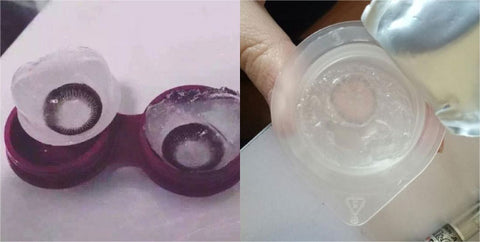How to Restore Frozen Colored Contact Lenses?
Using colored contact lenses to change your appearance is an intriguing option. However, when winter approaches, you can run into an unexpected problem: frozen contact lenses. Picture this: You eagerly purchase colored contacts online, but when the package arrives, the lenses are frozen, leaving you unhappy. If you've experienced this problem before, you know how frustrating and potential concerns it can be. In this essay, we will walk you through the processes required to properly recover frozen colored contact lenses, ensuring both your eye health and your attractive appearance are preserved.

What to Do If Your Contact Lenses Have Frozen?
Frozen contact lenses may be easily restored to their usable state. The solution is simple: let the frozen contact lens packages defrost at room temperature.
These contact lenses are safeguarded by the sterile solution they are stored in. The contact lenses will remain sterile as long as the packet's seal remains intact.
How long will it take to defrost?
The defrosting process requires patience, and it's crucial not to rush it. If you let your contacts thaw overnight, they should be fully ready for use by the next morning.
Attempting to accelerate the defrosting by exposing the frozen contacts to warmth is not advisable. Heat can alter the chemical composition of the solution, potentially compromising the quality of your contact lenses.
As long as you allow your contact lenses to thaw naturally at room temperature, they should remain undamaged. Until they do, you'll have to continue using your glasses for a bit longer.
My contact lenses have thawed; now what?
After your contacts have thawed, properly clean them with a new saline solution before inserting them into your eyes. After that, you're ready to enjoy a clear vision with your revitalized contacts!
Although it is unusual, if your contacts have been damaged or become uncomfortable due to being frozen, please discard the lens and contact us immediately for further assistance. Esoeye consistently provides excellent quality customer service.

My contact lenses become frozen in transit! What Can I Do to Help Them?
If your contact lenses have frozen during transit, it's important to take certain steps to analyze their status and perhaps save them. What you can do is as follows:
1. Examine the Lenses: First, thoroughly inspect the contact lenses for evident indications of damage or distortion. Look for cracks, rips, or changes in shape. It is advised not to use them if they seem damaged.
2. Thaw Gradually: Thaw the lenses gradually at room temperature. External heat sources, such as a microwave or hot water, should be avoided since they might harm the lenses.
3. Cleaning Method: After thawing the lenses, rinse them with sterile saline or multipurpose contact lens solution. Tap water should be avoided since it may contain toxins that might hurt your eyes.
4. Consider Your Comfort: After cleaning, gently check the lenses for any lingering damage or dirt with your fingers. You can try to insert them if they appear to be undamaged and clean.
5. Comfort and Vision: Take note of how the lenses feel on your eyes and whether or not your eyesight is clear. Remove the lenses immediately if you suffer pain or blurred vision.
Additional Tips for Wearing Contacts in Winter
Due to the dry and cold weather, using contact lenses throughout the winter months might provide some unique challenges. Consider the following additional guidelines for using contacts in winter to ensure your comfort and excellent eye health:
1. Moisturize Your Eyes: Use preservative-free artificial tears or contact lens-specific lubricating eye drops. Apply them on a daily basis to fight dryness produced by interior heating and cold, windy outside weather.
2. Stay Hydrated: To be adequately hydrated, drink lots of water. Hydration is important for maintaining the moisture balance in your eyes.
3. Moisturize Your Environment: Purchase a humidifier for your house or office. Increasing indoor humidity levels can help avoid excessive tear film evaporation, keeping your eyes pleasant.
4. Wear Protective Eyewear: Consider wearing sunglasses or goggles on windy and cold days to protect your eyes from wind, cold air, and possible debris. This can aid in reducing evaporation and avoiding irritation.
5. Limit Outdoor activity: On severely cold and windy days, limit lengthy outdoor activity. The combination of cold and wind can lead to quicker evaporation of tears and increased discomfort when wearing contacts.
6. Adjust Your Lens Care Routine: Use a hydrogen peroxide-based contact lens washing and disinfection system, as it can be gentler on the eyes compared to some multipurpose solutions. Carefully follow the manufacturer's directions.
7. Blink regularly: Keep your contact lenses wet and comfortable by blinking regularly. Long durations of staring at displays or reading without blinking might aggravate dryness.
8. Reduce Exposure to Heating Vents: Avoid sitting directly in front of heating vents, which can induce dryness and increase tear evaporation.
Remember that your eye health is vital, so if you feel prolonged pain, redness, or other strange symptoms when using contacts in the winter, get advice and examination from your eye care specialist. They may provide you with personalized guidance and recommendations depending on your individual requirements.


Leave a comment